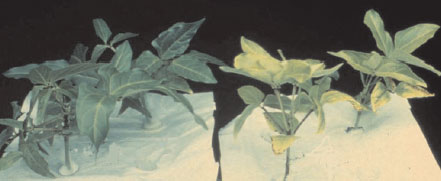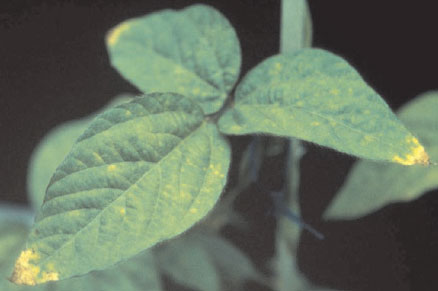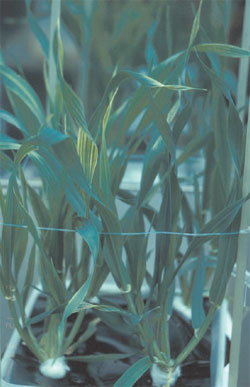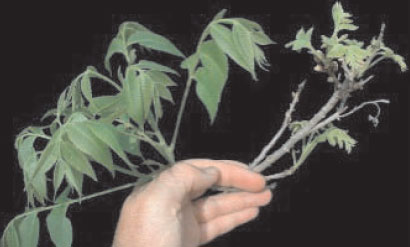Diagnosis of Nickel Status
Symptoms of Deficiency and Toxicity
In legumes and other dicotyledonous plants, nickel deficiency results in decreased activity of urease and subsequently in urea toxicity, exhibited as leaflet tip necrosis (9–11). With nitrogen-fixing plants or with plants grown on nitrate and ammonium, nickel deficiency results in a general suppression in plant growth with development of leaf tip necrosis on typically pale green leaves (9,10) (Figure 14.1 and Figure 14.2). These symptoms were attributed to the accumulation of toxic levels of urea in the leaf tissues. |
| FIGURE 14.1 Nitrogen-fixing cowpea seedlings (Vigna unguiculataWalp.) were grown for 40 days in nutrient solutions containing either 1 (left) or 0 �g L-1 (right) and supplied with no inorganic nitrogen source. In the absence of nickel, plants developed pronounced leaf tip necrosis and marked yellowing and growth stunting. The observed symptoms closely resemble those of nitrogen deficiency. |
 |
| FIGURE 14.2 Leaf tip necrosis in soybean plants (Glycine max Merr.) grown in nutrient solution provided with equimolar concentrations of nitrate and ammonium. Solutions were made free from nickel by first passing solutions through a nickel-specific chelation resin. Leaf tip necrosis was observed coincident with the commencement of flowering. |
In graminaceous species (Figure 14.3), deficiency symptoms include chlorosis similar to that induced by iron deficiency (1), including interveinal chlorosis and patchy necrosis in the youngest leaves. Nickel deficiency also results in a marked enhancement in plant senescence and a reduction in tissue-iron concentrations. In monocotyledons and in dicotyledons, the accumulation of urea in leaf tips is diagnostic of nickel deficiency. In early or incipient stages of nickel toxicity, no clearly visible symptoms develop, though shoot and root growth may be suppressed. Acute nickel toxicity results in symptoms that have variously been likened to iron deficiency (interveinal chlorosis in monocotyledons, mottling in dicotyledons) or zinc deficiency (chlorosis and restricted leaf expansion) (1,2,43). Severe toxicity results in complete foliar chlorosis with necrosis advancing in from the leaf margins, followed by plant death.
In pecan growing in the southeastern United States, the long-described but poorly understood symptoms of 'mouse-ear' or 'little-leaf disorder' (Figure 14.4) have recently been shown to be due to nickel deficiency that can be cured by application of nickel (at 100 mg L-1) (2). Nickel deficiency in pecan and in certain other woody perennial crops (e.g., plum, peach and pyracantha, and citrus) is characterized by
early-season leaf chlorosis, dwarfing of foliage, blunting of leaf or leaflet tips, necrosis of leaf or leaflet tips, curled leaf or leaflet margins, dwarfed internodes, distorted bud shape, brittle shoots, cold-injurylike death of over-wintering shoots, diminished root system with dead fibrous roots, failure of foliar lamina to develop, rosetting and loss of apical dominance, dwarfed trees, and tree death (Wood et al. (2))
 |
| FIGURE 14.3 Nickel deficiency symptoms in barley (Hordeum vulgare L. cv. Onda) following 50 days growth in nutrient solution containing equimolar concentrations of nitrate and ammonium. Symptoms include leaf-tip chlorosis and necrosis, development of thin 'rat-tail' leaves, and interveinal chlorosis of young leaves. |
 |
| FIGURE 14.4 Branches of nickel-sufficient (left) and nickel-deficient (right) pecan (Carya illinoinensis K. Koch). Symptoms include delayed and decreased leaf expansion, poor bud break, leaf bronzing and chlorosis, rosetting, and leaf tip necrosis. |
Nickel deficiency was long unrecognized in this region because of its similarity to zinc deficiency and as a consequence of a complex set of factors that influences its occurrence. Nickel deficiency is induced by: (a) excessively high soil zinc, copper, manganese, iron, calcium, or magnesium; (b) root damage by root-knot nematodes; or (c) dry or cool soils at the time of bud break (2). The conditions under which Ni deficiency occurs also commonly result in a deficiency of zinc or copper, and this fact has resulted in the extensive use of copper and zinc fertilizers over many years further exacerbating the nickel deficiency. In many horticultural tree species, heavy application of fertilizers with zinc, copper, or both nutrients is common for their nutritional values and benefits for leaf removal and disease protection. In many orchard crops recalcitrant physiological disorders and poorly understood replant 'diseases' are frequent suggesting that induced nickel deficiency may be much more widespread than was previously recognized.




